The Brazos Performance Preview: AMD E-350 Benchmarked
by Anand Lal Shimpi on November 16, 2010 12:01 AM ESTMobile IGP Comparison
I narrowed down the platforms for our mobile IGP comparison. I simulated a Core i3 350M by taking an i3-530, underclocking it (I couldn't do anything about the 4MB vs. 3MB L3 cache) and capping its GPU frequency at 667MHz. This is the best case scenario for the i3-350M, and as you'll see below, it doesn't really matter. I also paired a 2.2GHz Pentium Dual-Core with a G45 motherboard, agian simulating the cheaper mobile Pentium platform. Finally I installed Windows 7 on the 1.6GHz Core 2 Duo based 11-inch MacBook Air with its GeForce 320M to give you an idea of the upper bound for mobile performance with what might as well be a low end discrete GPU.
Updated: I've added performance results from a simulated Core i3-330UM, the E-350's competition in ultra portables.
We'll start with Modern Warfare 2:
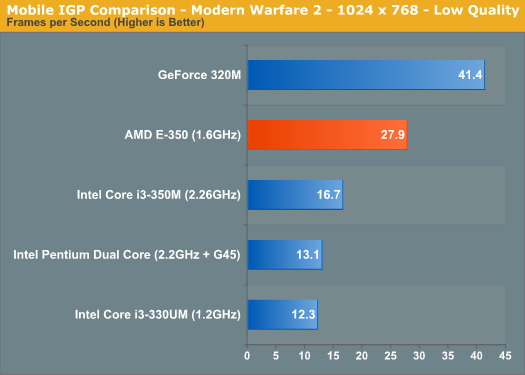
The E-350 puts the i3-350M, i3-330UM and Pentium DC to shame, delivering 67% better performance. The frame rate is just shy of being totally smooth however. I found that in most modern games 1024 x 768 would result in frame rates just under 30 fps.
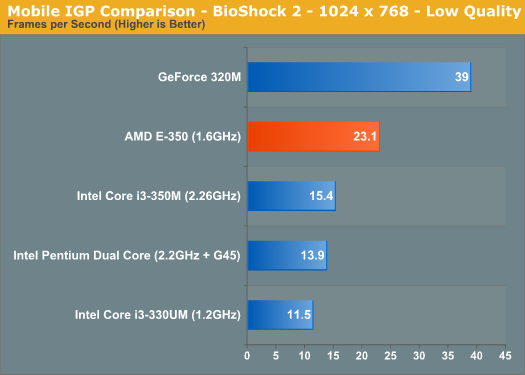
BioShock 2 showed a similar performance advantage. Again we're not able to break 30 fps but the performance advantage is huge compared to the Intel platforms with integrated graphics.
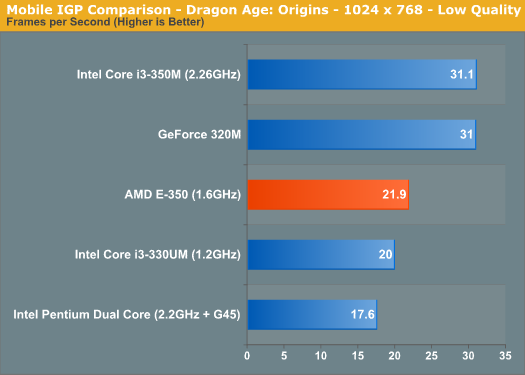
Dragon Age: Origins is mostly CPU bound at low quality settings and thus there's no real advantage to the E-350's Radeon HD 6310 GPU. It's faster than the Pentium/G45 platform, but significantly slower than the i3-350M. I expect most games however to be GPU bound at these settings across the board.
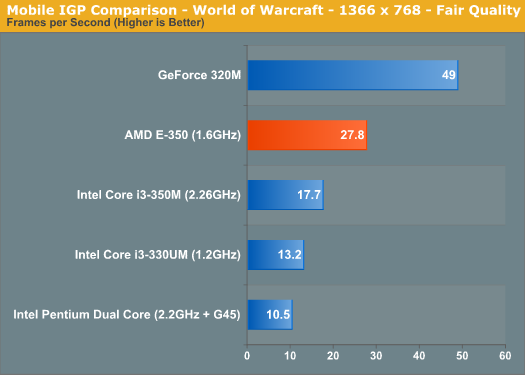
World of Warcraft continued the trend. The E-350 ended up 57% faster than the i3-350M, although still fell short of a discrete GPU.
Of course I wondered how well Brazos would play Starcraft 2:
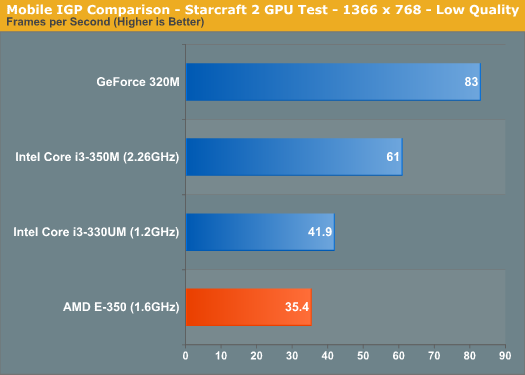
The GPU handles SC2 just fine, however the game is very CPU dependent and thus you see a pretty big advantage from the mainstream i3 system. The comparison is a lot closer when we look at the i3-330UM. The E-350 won't be able to play SC2 as well as a $500 mainstream notebook, but it'll be comparable to an ultraportable running ULV Arrandale.
We don't have numbers for the G45 platform here because the system wouldn't run our benchmark (our tests use an older version of SC2 which apparently had issues with the G45 drivers).
Our SC2 CPU test gives you an idea of the lower end of performance in large multiplayer battles:

The E-350 offers only 58% of the performance of the i3-350M system. The Bobcat cores do hold the platform back from time to time. Again, compared to the i3-330UM there's no performance difference at all.
Just for kicks I also ran the Civilization V benchmark, which gave us two datapoints: GPU performance and no-render/CPU performance.
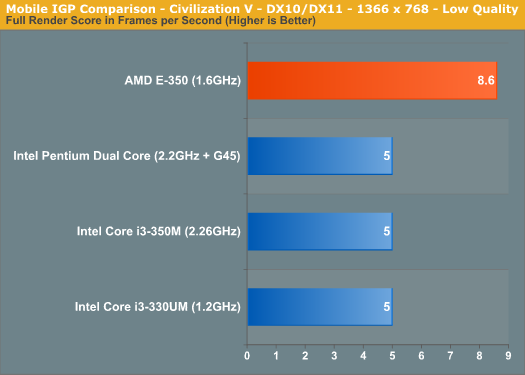
The benchmark doesn't score well on either platform, although AMD does hold a 72% performance advantage over the i3 and G45 platforms. The CPU test puts the E-350 at about 55% of the speed of the Pentium dual core platform.
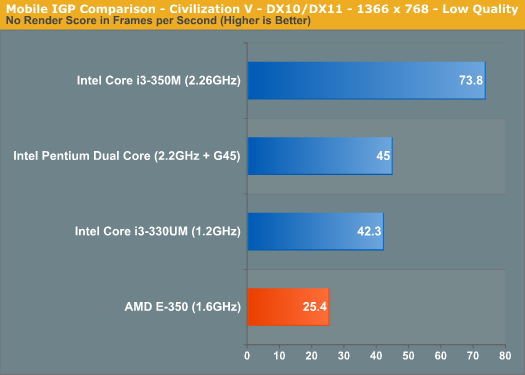
Civ V is one area where the Arrandale CPU advantage wins out over GPU performance.
Overall, the E-350 has no problems outperforming any of the current Intel integrated graphics offerings in 3D games. In CPU bound titles the E-350 loses out to the mainstream i3, but is competitive with ultra low voltage i3s. Just as with Atom, you'll have to sacrifice performance vs. a mainstream notebook, but compared to low voltage Arrandale the E-350 can hold its own.










207 Comments
View All Comments
svojoe - Wednesday, November 17, 2010 - link
I'm sure it was not easy to do a full suite of testing, But I would *really* like to see the Brazos pitted against the ATOM/ION or the CULV/ION Platforms. Despite atom's really slow performance for the same price ranges even today I am still amazed that my single core ATOM (hp mini 311) paired with ION is hard to beat in the 11.6" and below form factor for multimedia and gaming at a sub $400 price tag.I know that I am a small niche in the market I want netbook/ultraportable form factors that are potent at gaming/multimedia that are also cheap. Can the Brazos answer in this category too or will the dual core ATOM/ION system's still rule when it gets down to raw cost and fps?
Cloakstar - Wednesday, November 17, 2010 - link
The chip may be memory bandwidth limited, but AMD was kind enough to demonstrate what now is best termed as a ~30% memory overclock at IDF. As long as the retail mobtherboards have even a few clock options, the raw TDP looks like it should provide a ton of headroom for the rest of the chip to clock up to consume that memory bandwidth.Brazos TDP: 21W ... Load power: 6.5W
"The Brazos platform was configured with 4GB of DDR3-1066 memory. The IDF system had memory running at DDR3-1333, however AMD had to decrease clocks presumably to meet validation requirements for final silicon."
"The Radeon HD 6310 in the E-350 does very well, despite the memory bandwidth limitations."
silverblue - Wednesday, November 17, 2010 - link
I put 2GB extra in my PC the other week and had to up a couple of the timings to make it work. I wonder how memory timings will affect the GPU's performance.Without a full rundown on what the system had, we won't know if AMD could've put better RAM in there, for example. I doubt they'd be sandbagging.
GeorgeH - Wednesday, November 17, 2010 - link
They're only a good value option because Intel doesn't care to offer their superior products with similarly thin profit margins.If Intel were to release a P4 for $0.50, it would be a fantastic value option for a lot of applications and users, but that doesn't change the fact that a P4 core is substandard when compared to a Nehalem core.
GeorgeH - Wednesday, November 17, 2010 - link
I wouldn't call it a myth so much as slightly disingenuous. Painting with a broad brush, there are two types of compute tasks - those that are arithmetically intense and those that aren't. Typically those that aren't are integer/boolean, and the rest are float. GPUs are great with most arithmetically intense operations, so they get conflated with float problems while leaving CPUs for the rest.It isn't completely precise to say CPUs are for integers and GPUs are for floats, as both can work with and excel at using either, but it's a good approximation when you start talking about real-world tasks a typical user will want to complete that take a significant amount of time to run.
krazyderek - Wednesday, November 17, 2010 - link
by the looks of things, AMD has made a good cut in power usage, at the expense of looking CPU competitive.Why don't they just release a E-460 with 3 bobcat cores at 1.6ghz, or 2 cores at 1.8ghz that will leave Atom in the dust and truly compete with i3 ?? looks like that would only take it up to ~27w which would be on par...
maybe it's just me, but when something new comes out, i don't care if just battery life has gone up, or any other one metric for that matter, i want to see better everything... battery life, graphics, and cpu, otherwise i just wait till the next generation when they've all been addressed.
sinigami - Wednesday, November 17, 2010 - link
uh, am i missing some charts on page 4 or something? because i only see three, and the zacate wins only the first one, ties on the second one, and loses on the third. With only one win, the headline should NOT say it's faster!you could say that the Clarkdale IGP wins or ties the zacate on two out of three gaming benchmarks, and declare it faster.
sheesh, is that some biasedness, or just wishful thinking?
StormyParis - Thursday, November 18, 2010 - link
you're testing games on this eminently non-gaming platform, but not video ?sinigami - Friday, November 19, 2010 - link
not just is it weird that they tested games, it's even weirder that they tested three games, and the headline said this platform was faster than intel's....WHEN IT ONLY WON ONE TEST!
did anyone else even read to page 4?
silverblue - Friday, November 19, 2010 - link
One thing to point out is that the i5-661 has a 900MHz GPU, the i3-530 a 733MHz GPU and the 890GX a 700MHz GPU. This particular flavour of Brazos is a mere 500MHz. Also, Anand is right in that, if most games are GPU bound, Brazos is easily superior to most integrated solutions and definitely so at the same GPU clock speed.